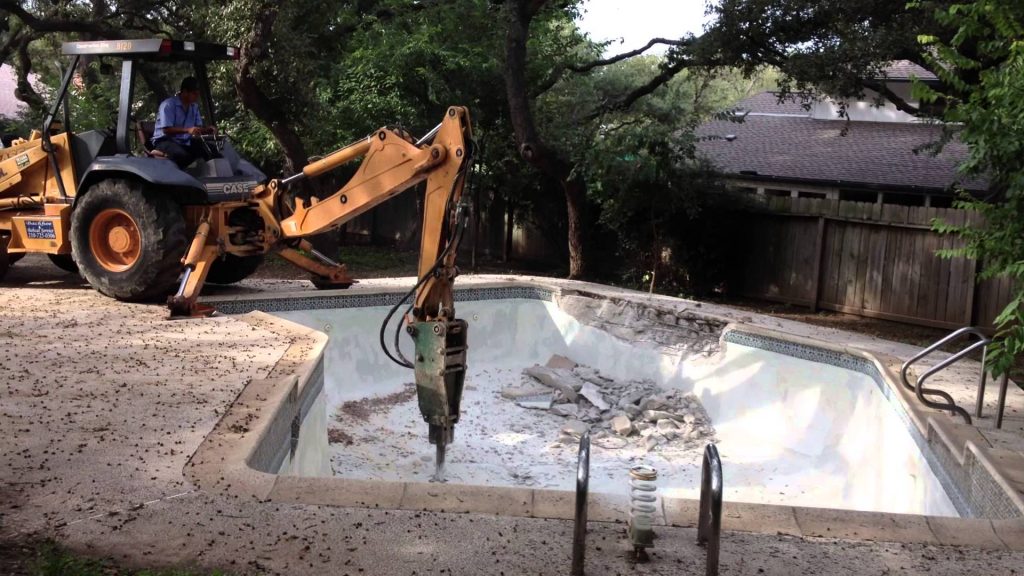Swimming pool removal is a big job that requires careful planning and execution. While removing a pool from your backyard eliminates future maintenance and upkeep costs, it also creates a temporary construction site. By following some best practices, you can ensure the pool removal process goes as smoothly as possible.
Swimming Pool Removal
Removing an inground swimming pool is a multi-step process that usually takes one to two weeks to complete depending on the size of the pool. The overall process involves draining the water, breaking up and removing the pool shell and decking materials, grading and landscaping the site, and disposing of all debris.
While pool demolition creates short-term disruption, it ultimately simplifies your yard and reduces long-term obligations. With proper preparation and execution of the pool removal project, you can minimize hassles and get your yard back to normal more quickly. Here are 10 tips for ensuring a smooth swimming pool removal:
1. Get the Necessary Permits
Most municipalities require a permit for pool demolition. Contact your local building department well in advance of the planned removal date to inquire about permit requirements. You may need to provide plans detailing how the pool area will be backfilled and graded. Getting the permits lined up early avoids delays.
2. Hire a Licensed Pool Removal Contractor
It’s generally not recommended to remove a pool yourself unless you have extensive construction experience. Most local codes require hiring a licensed pool removal contractor who is insured and knows proper demolition, waste disposal, and site restoration methods. Ask for references from past clients.
3. Disconnect Utilities
Ensure the pool equipment is disconnected from power sources and water lines well before demolition. Coordinate with your utility providers to have gas, electric, and water services shut off and capped in advance. Disconnect underground lines from the house if necessary.
4. Drain the Water
A pumping contractor can drain most residential pools within a day. Remove all deck furniture/accessories so they don’t end up submerged. Drain to just above the intake line before demolishing the shell.
5. Remove Pool Chemicals
Properly dispose of any remaining chlorine tablets, acid, or other chemicals left in the pool equipment or storage areas before removal work begins. Look up hazardous waste collection guidelines for your area.
6. Alert Neighbors
Give neighbors a heads-up about planned demolition and site work dates so they understand it’s a temporary situation. Provide contact info in case any issues arise. Demolition can generate noise, dust and truck traffic.
7. Secure the Site
Erect temporary fencing around the pool area if young children or pets will be in the yard during work. Put up caution tape or signs as needed.
8. Clear Clutter from Area
Remove or store anything moveable, like furniture, garden items or toys from the demolition zone before work begins to keep all clear of debris.
9. Haul Debris Promptly
Demolition creates lots of waste – broken concrete, rebar, plumbing, etc. Schedule frequent debris removal by your contractor to prevent a messy jobsite that affects neighbors. Require daily clean-ups.
10. Restore and Landscape the Site
Backfilling, grading and laying new topsoil or sod should be part of the pool removal contract. Consider updating your yard’s design to maximize use of the former pool space. Planting shrubs or trees helps beautify the repurposed area.
Managing Expectations
Effective communication is key to a smooth pool removal process. Clearly layout expectations for cleanup, work hours and completion dates with your contractor in advance. Address payment schedules too. Address any issues that arise promptly and professionally. Though disruptive, follow through ensures your yard is restored properly. With a planned approach and responsible contractor, you can minimize hassles from swimming pool removal.
Contractor Considerations
When hiring a pool removal contractor, check that they carry general liability insurance and workers compensation. Ask for and contact references. Look for a company that specializes in pool demolition, has experienced crews, and will properly dispose of all waste materials. Request estimated job costs and timelines in writing. Reputable outfits are licensed, bonded and willing to offer warranties on their work. Opt for established local firms versus fly-by-night operations.
Preparing the Pool Area
Before work starts, carefully rake and remove any loose debris from inside the pool. Be sure drain lines are clear for complete drainage. Power wash the decks if needed. Store or move any landscaping, furniture or fixtures you want to keep away from the pool zone temporarily. Disconnect and remove pool equipment. Secure the tools and materials required before demolition. An organized site makes the job safer and more efficient.
The Demolition Process
First, the drainage grates and skimmers will be removed from the pool. Then, the crew will chip away the concrete pool shell using pneumatic jackhammers or an excavator with a breaker attachment. As sections crumble, the debris is loaded into dump trucks.
Next, the reinforcing steel skeleton known as rebar will be pulled from the rubble. Underground plumbing, wiring and drains are excavated and severed. Pool ladders, diving boards and other hardware come off. The base and any above-ground equipment shelter get demolished too.
Backfilling and Restoration
With the pool structure leveled, qualified operators will backfill using select structural fill dirt or gravel in layers, compacting as they proceed up to natural grade. The area will be fine graded to blend seamlessly with surrounding lawn or landscaping. Topsoil installed, the finished surface is ready for seeding, sod or replanting to complete the process.
Summary
In summary, removing a swimming pool requires careful advance planning but can transform an outdated recreational area into a low-maintenance, functional yard space. Following the tips outlined here helps a pool demolition project stay on track timeline-wise while minimizing hassles for homeowners. With proper preparation and oversight, pool removal need not be overly disruptive when handled by experienced contractors.

